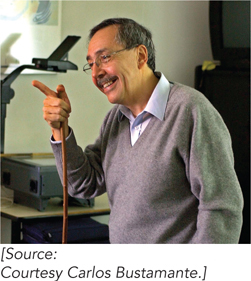Chapter Introduction
9: Topology: Functional Deformations of DNA
297
MOMENT OF DISCOVERY

There was an experiment I had wanted to do for many years, but I could never convince anyone to try it. The idea was to measure the elastic properties of DNA directly using a single molecule of DNA tethered between two opposing pipette tips, such that it could be exquisitely controlled by rotating one pipette tip relative to the other to twist the DNA to different extents. In solution, DNA can twist on its long axis, and it can also writhe by coiling around itself—
After many students turned me down, eventually two students, Zev Bryant and Michael Stone, were intrigued to try the DNA twisting experiment. These guys worked very hard setting up the technical aspects of the experiment. They figured out how to tether the ends of a nicked fragment of DNA to two opposing pipette tips, and they coupled a readily visualized small bead (the “rotor”) to an internal position in the nicked DNA duplex. They finally got everything working late one night. Zev and Michael started using a hand crank to introduce a specific number of twists into the tethered piece of DNA. But they were so tired that they would get up to, say, 345 turns, and then they weren’t sure if it was 345 or 346! They were determined to do the experiment accurately, so they had to untwist the DNA and start over. But Jan Liphardt, another student in the lab, had an idea. He offered to bring in a small motor from his Lego set at home to rotate the pipette tip, and thus twist the DNA, automatically. So Jan ran home and got the motor, hooked it up to the system, and it worked beautifully. All the data we ultimately published were measured using the Lego motor (we even listed it in the Methods section of the paper). And we learned that DNA is about 50% stiffer than had been previously estimated from bulk solution experiments!
—Carlos Bustamante, on discovering the elasticity of DNA
298
In all free-
Before we explore the enzymes of DNA replication, repair, recombination, and transcription and their regulation in chapters to come, we need to consider the chromosome—
As we will see, DNA is compacted primarily by coiling. The process is somewhat analogous to rolling up a length of garden hose, an old-
Building on our discussion of DNA secondary structure in Chapter 6, in this chapter and the next we address the tertiary structure and function of chromosomes. First, in this chapter, we introduce the extraordinary degree of organization required for the tertiary packaging of DNA into chromosomes. We explore the principles related to the compaction of DNA, beginning with a review of the structural elements that make up viral and cellular chromosomes, and consider chromosomal size and organization in more detail. We then discuss DNA topology, for a quantitative description of the coiling and supercoiling of DNA molecules. We conclude the chapter with a discussion of the key enzymes found in all cells that are involved in creating and maintaining a very high order of compaction. As in all other areas of molecular biology, this information is not merely of academic interest. Many of these enzymes are important targets of antibiotics and other medicines. In Chapter 10, we expand on this discussion of tertiary packaging by examining the complete structure of chromosomes in the context of the structural DNA-